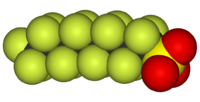
Photo from wikipedia
BACKGROUND Perfluoroalkyl substances (PFASs) are pollutants that tend to accumulate in the environment and organisms. The animal and human studies to date have focused on thyroid function, but the results… Click to show full abstract
BACKGROUND Perfluoroalkyl substances (PFASs) are pollutants that tend to accumulate in the environment and organisms. The animal and human studies to date have focused on thyroid function, but the results are inconsistent. METHODS A sample of 118 mother-infant pairs was obtained from the Taiwan Birth Panel Study (TBPS). Cord blood PFASs levels were evaluated using the Waters ACQUITY UPLC system coupled with a Waters Quattro Premier XE triple quadrupole mass spectrometer, and cord blood thyroid hormones were assessed using a Roche Analytics E170 modular analyser (Roche Diagnostics, Mannheim, Germany). PFASs concentrations were analysed in the final models to examine the associations between cord blood PFASs levels and thyroid hormone concentrations. RESULTS The cord blood perfluorooctane sulfonate (PFOS) concentration was negatively associated with the cord blood thyroxine (T4) concentration [per ln unit: adjusted β (95% confidence interval, CI) = -0.458(-0.916, -0.001)]. Moreover, the level of cord blood thyroid stimulating hormone (TSH) was positively associated with the cord blood PFOS concentration [per ln unit: adjusted β (95% confidence interval, CI) = 0.346(0.101, 0.592)]. The sex stratified effects of PFOS on T4 were suggestive of differential effects in high-exposure groups compared with low-exposure group in boys. CONCLUSIONS We found that cord blood thyroid hormone levels are affected by PFASs, with a negative association between T4 and PFOS and a positive association between TSH and PFOS. The causal associations of thyroid hormones and PFASs require further exploration.
Journal Title: Environmental pollution
Year Published: 2017
Link to full text (if available)
Share on Social Media: Sign Up to like & get
recommendations!